Object-Oriented Language: Definitions, Concepts, and Terminology
VerifiedAdded on 2020/02/19
|8
|1494
|69
Report
AI Summary
This report provides a comprehensive overview of object-oriented programming (OOP) concepts. It begins by defining procedural programming and then delves into the core principles of OOP, including the definition of objects, classes, attributes, and methods. The report explains key concepts such as constructors, polymorphism, inheritance, and the roles of superclasses and subclasses. It further elucidates encapsulation, arrays within OOP, and the Unified Modeling Language (UML). The report also covers instance variables, exception handling (including throwing and catching exceptions), static members, and garbage collection. Each concept is clearly defined, providing a solid foundation for understanding object-oriented programming principles. The report concludes with a list of relevant references supporting the definitions.

Running head: OBJECT-ORIENTED LANGUAGE
Object-Oriented Language
Name of the student:
Name of the university:
Author Note
Object-Oriented Language
Name of the student:
Name of the university:
Author Note
Paraphrase This Document
Need a fresh take? Get an instant paraphrase of this document with our AI Paraphraser
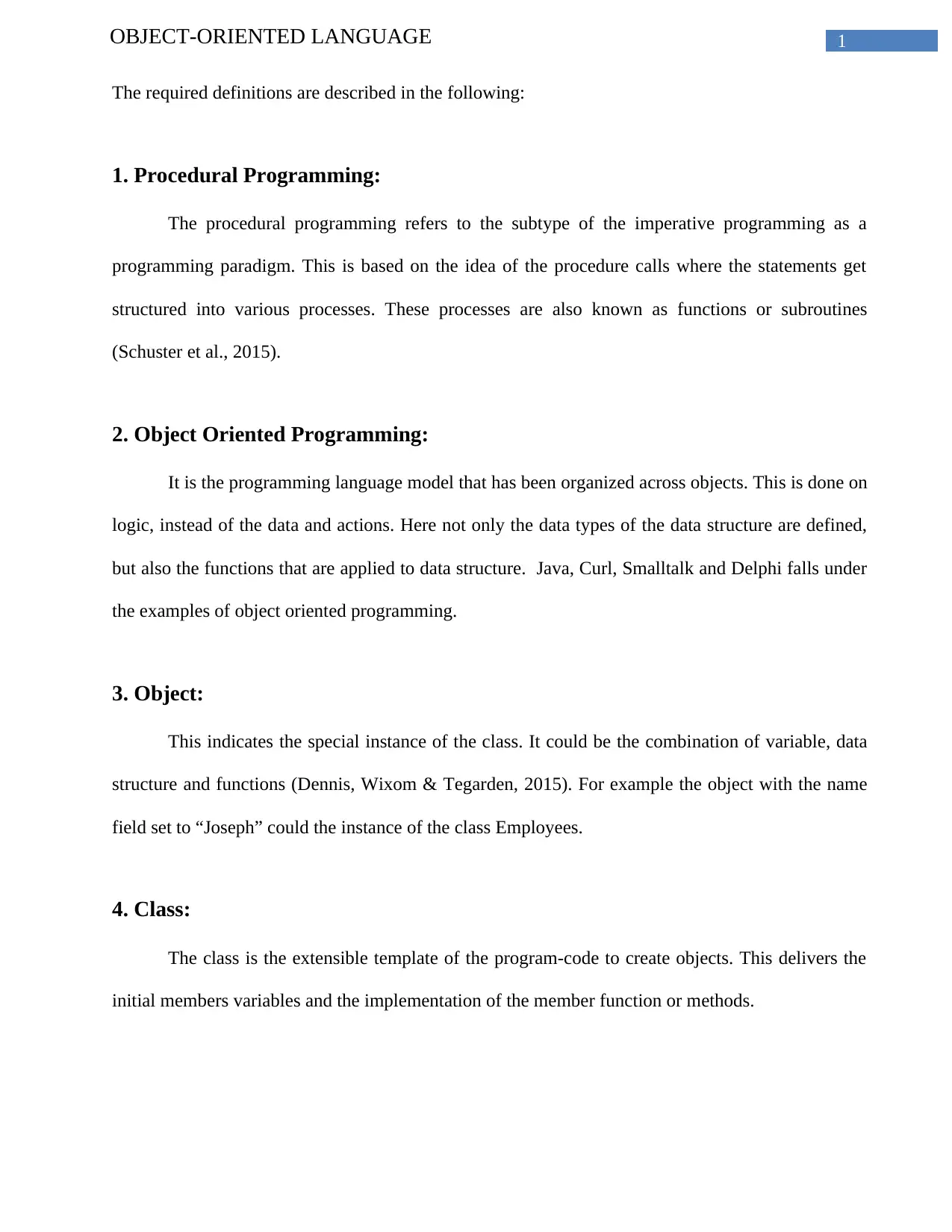
1OBJECT-ORIENTED LANGUAGE
The required definitions are described in the following:
1. Procedural Programming:
The procedural programming refers to the subtype of the imperative programming as a
programming paradigm. This is based on the idea of the procedure calls where the statements get
structured into various processes. These processes are also known as functions or subroutines
(Schuster et al., 2015).
2. Object Oriented Programming:
It is the programming language model that has been organized across objects. This is done on
logic, instead of the data and actions. Here not only the data types of the data structure are defined,
but also the functions that are applied to data structure. Java, Curl, Smalltalk and Delphi falls under
the examples of object oriented programming.
3. Object:
This indicates the special instance of the class. It could be the combination of variable, data
structure and functions (Dennis, Wixom & Tegarden, 2015). For example the object with the name
field set to “Joseph” could the instance of the class Employees.
4. Class:
The class is the extensible template of the program-code to create objects. This delivers the
initial members variables and the implementation of the member function or methods.
The required definitions are described in the following:
1. Procedural Programming:
The procedural programming refers to the subtype of the imperative programming as a
programming paradigm. This is based on the idea of the procedure calls where the statements get
structured into various processes. These processes are also known as functions or subroutines
(Schuster et al., 2015).
2. Object Oriented Programming:
It is the programming language model that has been organized across objects. This is done on
logic, instead of the data and actions. Here not only the data types of the data structure are defined,
but also the functions that are applied to data structure. Java, Curl, Smalltalk and Delphi falls under
the examples of object oriented programming.
3. Object:
This indicates the special instance of the class. It could be the combination of variable, data
structure and functions (Dennis, Wixom & Tegarden, 2015). For example the object with the name
field set to “Joseph” could the instance of the class Employees.
4. Class:
The class is the extensible template of the program-code to create objects. This delivers the
initial members variables and the implementation of the member function or methods.
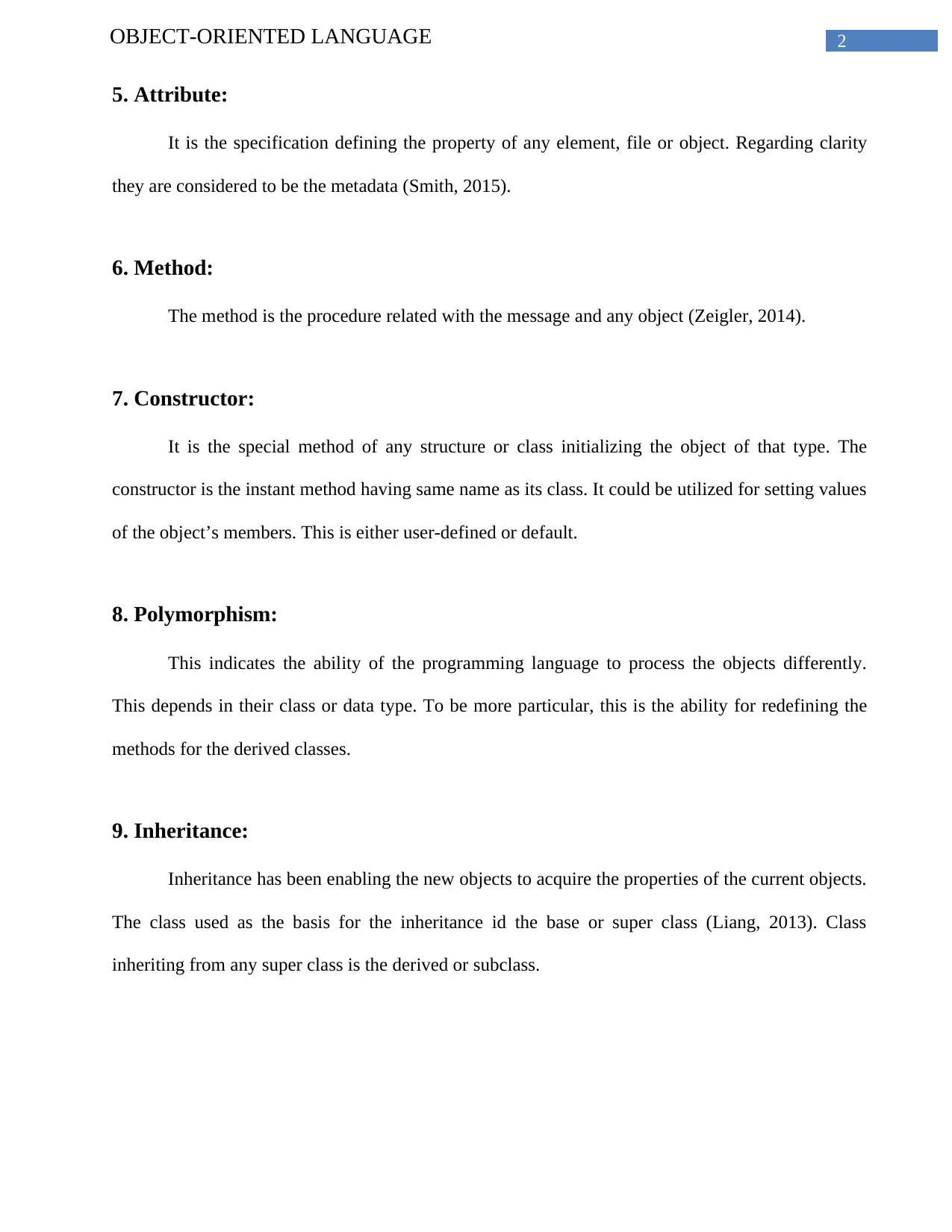
2OBJECT-ORIENTED LANGUAGE
5. Attribute:
It is the specification defining the property of any element, file or object. Regarding clarity
they are considered to be the metadata (Smith, 2015).
6. Method:
The method is the procedure related with the message and any object (Zeigler, 2014).
7. Constructor:
It is the special method of any structure or class initializing the object of that type. The
constructor is the instant method having same name as its class. It could be utilized for setting values
of the object’s members. This is either user-defined or default.
8. Polymorphism:
This indicates the ability of the programming language to process the objects differently.
This depends in their class or data type. To be more particular, this is the ability for redefining the
methods for the derived classes.
9. Inheritance:
Inheritance has been enabling the new objects to acquire the properties of the current objects.
The class used as the basis for the inheritance id the base or super class (Liang, 2013). Class
inheriting from any super class is the derived or subclass.
5. Attribute:
It is the specification defining the property of any element, file or object. Regarding clarity
they are considered to be the metadata (Smith, 2015).
6. Method:
The method is the procedure related with the message and any object (Zeigler, 2014).
7. Constructor:
It is the special method of any structure or class initializing the object of that type. The
constructor is the instant method having same name as its class. It could be utilized for setting values
of the object’s members. This is either user-defined or default.
8. Polymorphism:
This indicates the ability of the programming language to process the objects differently.
This depends in their class or data type. To be more particular, this is the ability for redefining the
methods for the derived classes.
9. Inheritance:
Inheritance has been enabling the new objects to acquire the properties of the current objects.
The class used as the basis for the inheritance id the base or super class (Liang, 2013). Class
inheriting from any super class is the derived or subclass.
⊘ This is a preview!⊘
Do you want full access?
Subscribe today to unlock all pages.

Trusted by 1+ million students worldwide
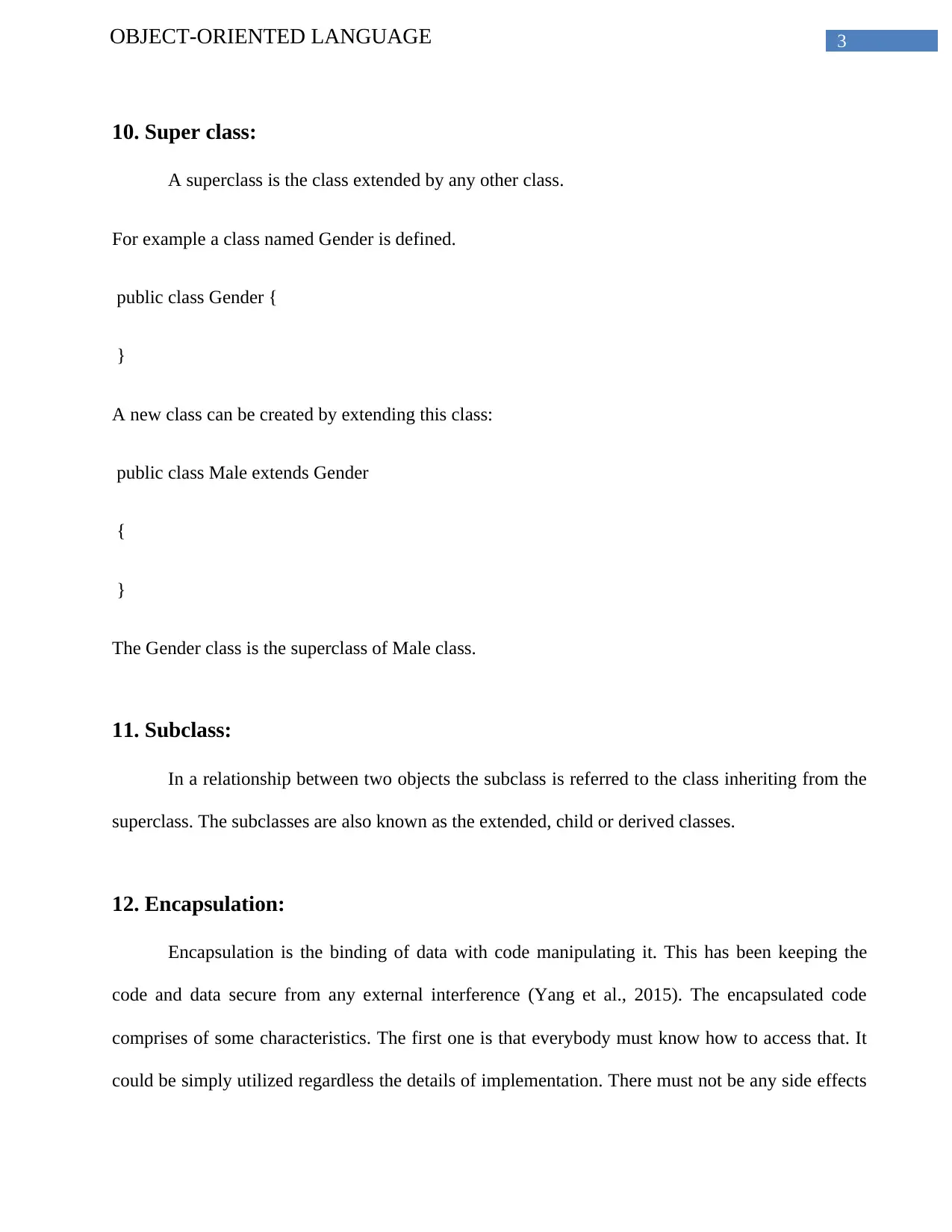
3OBJECT-ORIENTED LANGUAGE
10. Super class:
A superclass is the class extended by any other class.
For example a class named Gender is defined.
public class Gender {
}
A new class can be created by extending this class:
public class Male extends Gender
{
}
The Gender class is the superclass of Male class.
11. Subclass:
In a relationship between two objects the subclass is referred to the class inheriting from the
superclass. The subclasses are also known as the extended, child or derived classes.
12. Encapsulation:
Encapsulation is the binding of data with code manipulating it. This has been keeping the
code and data secure from any external interference (Yang et al., 2015). The encapsulated code
comprises of some characteristics. The first one is that everybody must know how to access that. It
could be simply utilized regardless the details of implementation. There must not be any side effects
10. Super class:
A superclass is the class extended by any other class.
For example a class named Gender is defined.
public class Gender {
}
A new class can be created by extending this class:
public class Male extends Gender
{
}
The Gender class is the superclass of Male class.
11. Subclass:
In a relationship between two objects the subclass is referred to the class inheriting from the
superclass. The subclasses are also known as the extended, child or derived classes.
12. Encapsulation:
Encapsulation is the binding of data with code manipulating it. This has been keeping the
code and data secure from any external interference (Yang et al., 2015). The encapsulated code
comprises of some characteristics. The first one is that everybody must know how to access that. It
could be simply utilized regardless the details of implementation. There must not be any side effects
Paraphrase This Document
Need a fresh take? Get an instant paraphrase of this document with our AI Paraphraser
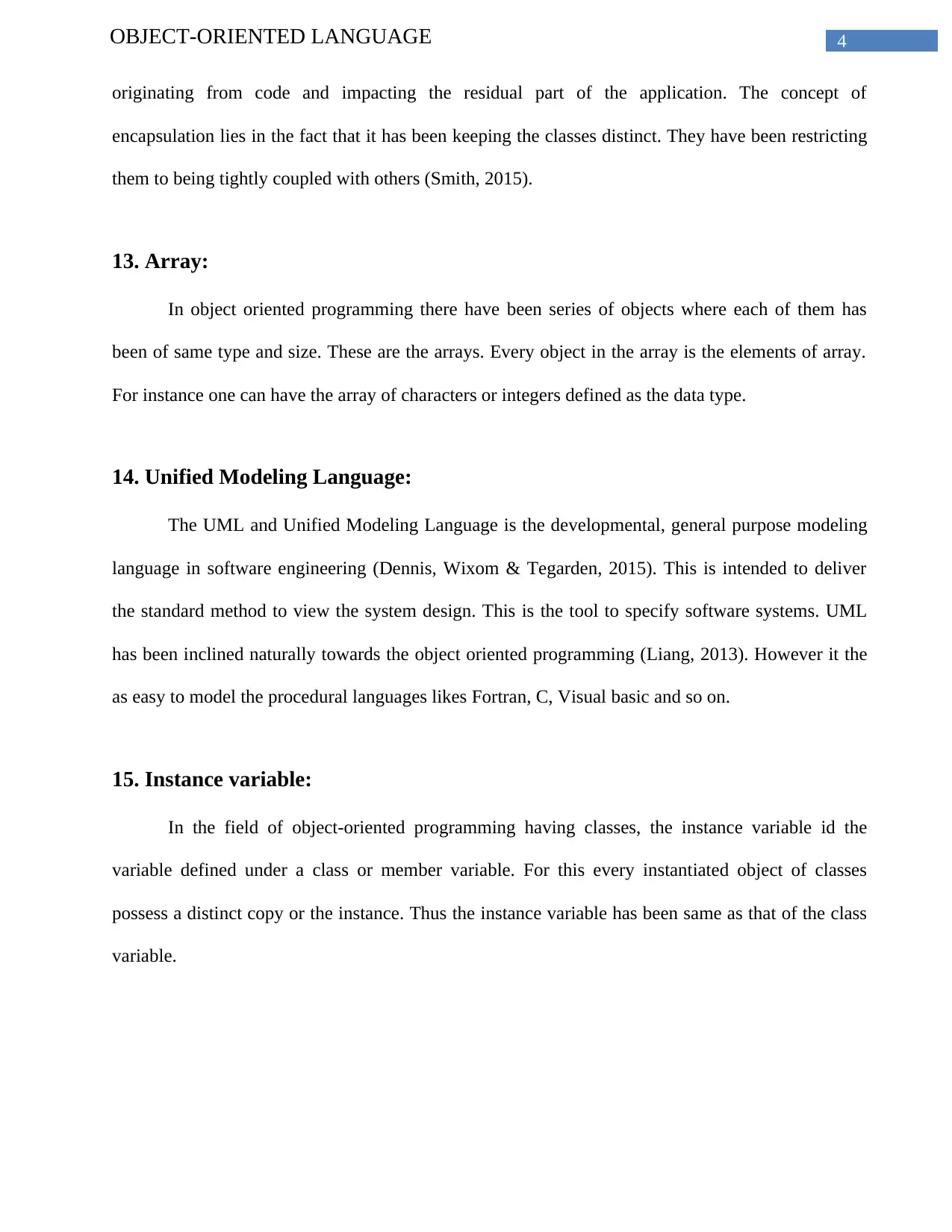
4OBJECT-ORIENTED LANGUAGE
originating from code and impacting the residual part of the application. The concept of
encapsulation lies in the fact that it has been keeping the classes distinct. They have been restricting
them to being tightly coupled with others (Smith, 2015).
13. Array:
In object oriented programming there have been series of objects where each of them has
been of same type and size. These are the arrays. Every object in the array is the elements of array.
For instance one can have the array of characters or integers defined as the data type.
14. Unified Modeling Language:
The UML and Unified Modeling Language is the developmental, general purpose modeling
language in software engineering (Dennis, Wixom & Tegarden, 2015). This is intended to deliver
the standard method to view the system design. This is the tool to specify software systems. UML
has been inclined naturally towards the object oriented programming (Liang, 2013). However it the
as easy to model the procedural languages likes Fortran, C, Visual basic and so on.
15. Instance variable:
In the field of object-oriented programming having classes, the instance variable id the
variable defined under a class or member variable. For this every instantiated object of classes
possess a distinct copy or the instance. Thus the instance variable has been same as that of the class
variable.
originating from code and impacting the residual part of the application. The concept of
encapsulation lies in the fact that it has been keeping the classes distinct. They have been restricting
them to being tightly coupled with others (Smith, 2015).
13. Array:
In object oriented programming there have been series of objects where each of them has
been of same type and size. These are the arrays. Every object in the array is the elements of array.
For instance one can have the array of characters or integers defined as the data type.
14. Unified Modeling Language:
The UML and Unified Modeling Language is the developmental, general purpose modeling
language in software engineering (Dennis, Wixom & Tegarden, 2015). This is intended to deliver
the standard method to view the system design. This is the tool to specify software systems. UML
has been inclined naturally towards the object oriented programming (Liang, 2013). However it the
as easy to model the procedural languages likes Fortran, C, Visual basic and so on.
15. Instance variable:
In the field of object-oriented programming having classes, the instance variable id the
variable defined under a class or member variable. For this every instantiated object of classes
possess a distinct copy or the instance. Thus the instance variable has been same as that of the class
variable.
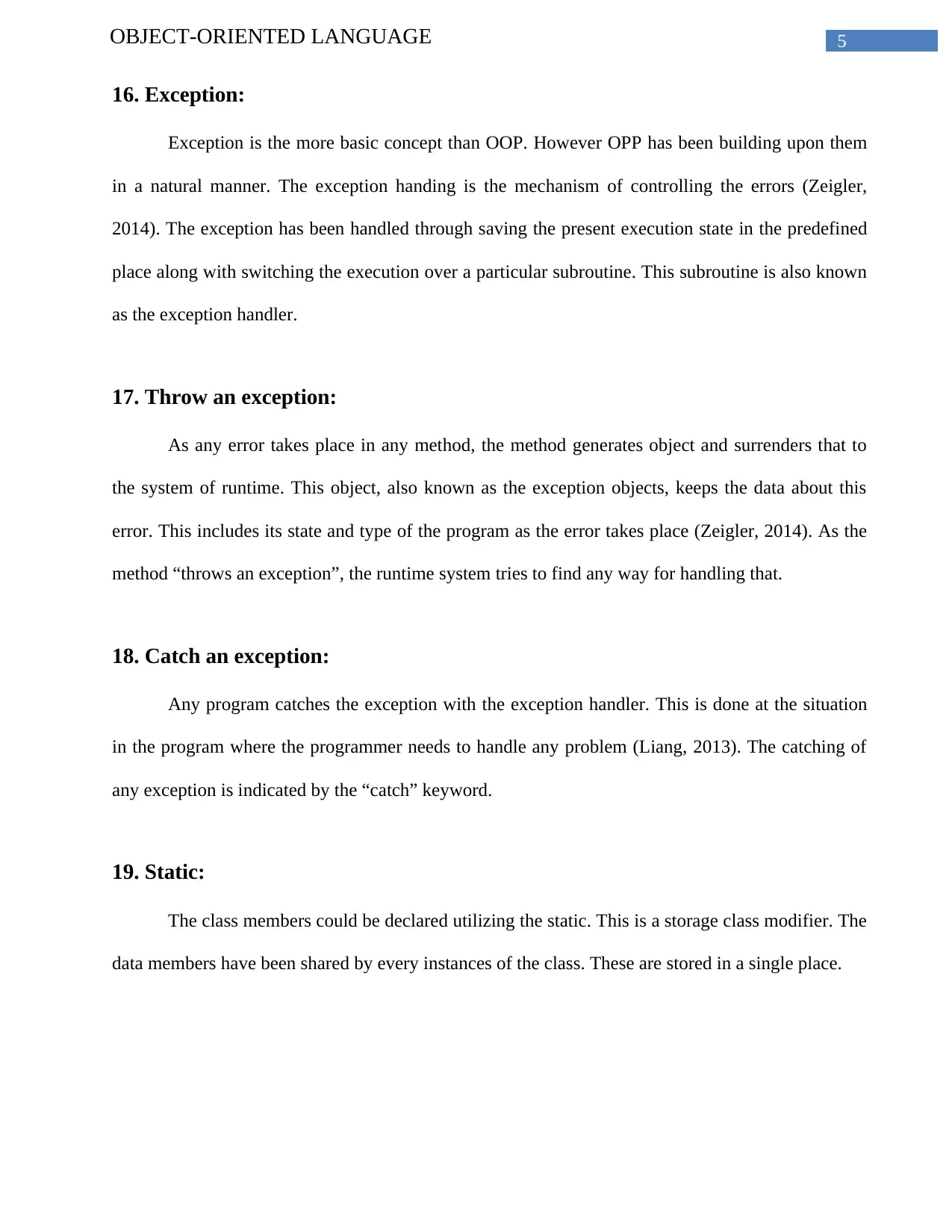
5OBJECT-ORIENTED LANGUAGE
16. Exception:
Exception is the more basic concept than OOP. However OPP has been building upon them
in a natural manner. The exception handing is the mechanism of controlling the errors (Zeigler,
2014). The exception has been handled through saving the present execution state in the predefined
place along with switching the execution over a particular subroutine. This subroutine is also known
as the exception handler.
17. Throw an exception:
As any error takes place in any method, the method generates object and surrenders that to
the system of runtime. This object, also known as the exception objects, keeps the data about this
error. This includes its state and type of the program as the error takes place (Zeigler, 2014). As the
method “throws an exception”, the runtime system tries to find any way for handling that.
18. Catch an exception:
Any program catches the exception with the exception handler. This is done at the situation
in the program where the programmer needs to handle any problem (Liang, 2013). The catching of
any exception is indicated by the “catch” keyword.
19. Static:
The class members could be declared utilizing the static. This is a storage class modifier. The
data members have been shared by every instances of the class. These are stored in a single place.
16. Exception:
Exception is the more basic concept than OOP. However OPP has been building upon them
in a natural manner. The exception handing is the mechanism of controlling the errors (Zeigler,
2014). The exception has been handled through saving the present execution state in the predefined
place along with switching the execution over a particular subroutine. This subroutine is also known
as the exception handler.
17. Throw an exception:
As any error takes place in any method, the method generates object and surrenders that to
the system of runtime. This object, also known as the exception objects, keeps the data about this
error. This includes its state and type of the program as the error takes place (Zeigler, 2014). As the
method “throws an exception”, the runtime system tries to find any way for handling that.
18. Catch an exception:
Any program catches the exception with the exception handler. This is done at the situation
in the program where the programmer needs to handle any problem (Liang, 2013). The catching of
any exception is indicated by the “catch” keyword.
19. Static:
The class members could be declared utilizing the static. This is a storage class modifier. The
data members have been shared by every instances of the class. These are stored in a single place.
⊘ This is a preview!⊘
Do you want full access?
Subscribe today to unlock all pages.

Trusted by 1+ million students worldwide
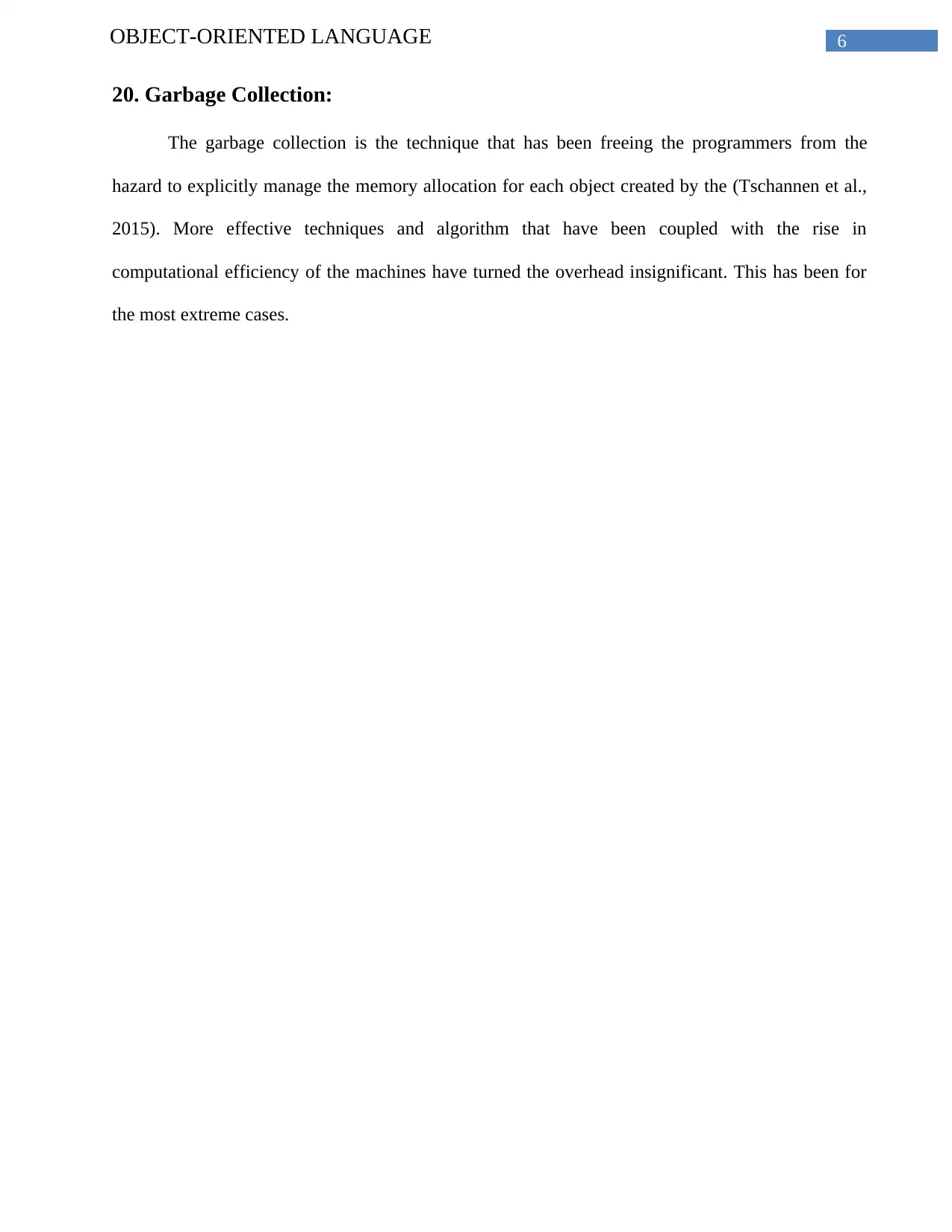
6OBJECT-ORIENTED LANGUAGE
20. Garbage Collection:
The garbage collection is the technique that has been freeing the programmers from the
hazard to explicitly manage the memory allocation for each object created by the (Tschannen et al.,
2015). More effective techniques and algorithm that have been coupled with the rise in
computational efficiency of the machines have turned the overhead insignificant. This has been for
the most extreme cases.
20. Garbage Collection:
The garbage collection is the technique that has been freeing the programmers from the
hazard to explicitly manage the memory allocation for each object created by the (Tschannen et al.,
2015). More effective techniques and algorithm that have been coupled with the rise in
computational efficiency of the machines have turned the overhead insignificant. This has been for
the most extreme cases.
Paraphrase This Document
Need a fresh take? Get an instant paraphrase of this document with our AI Paraphraser
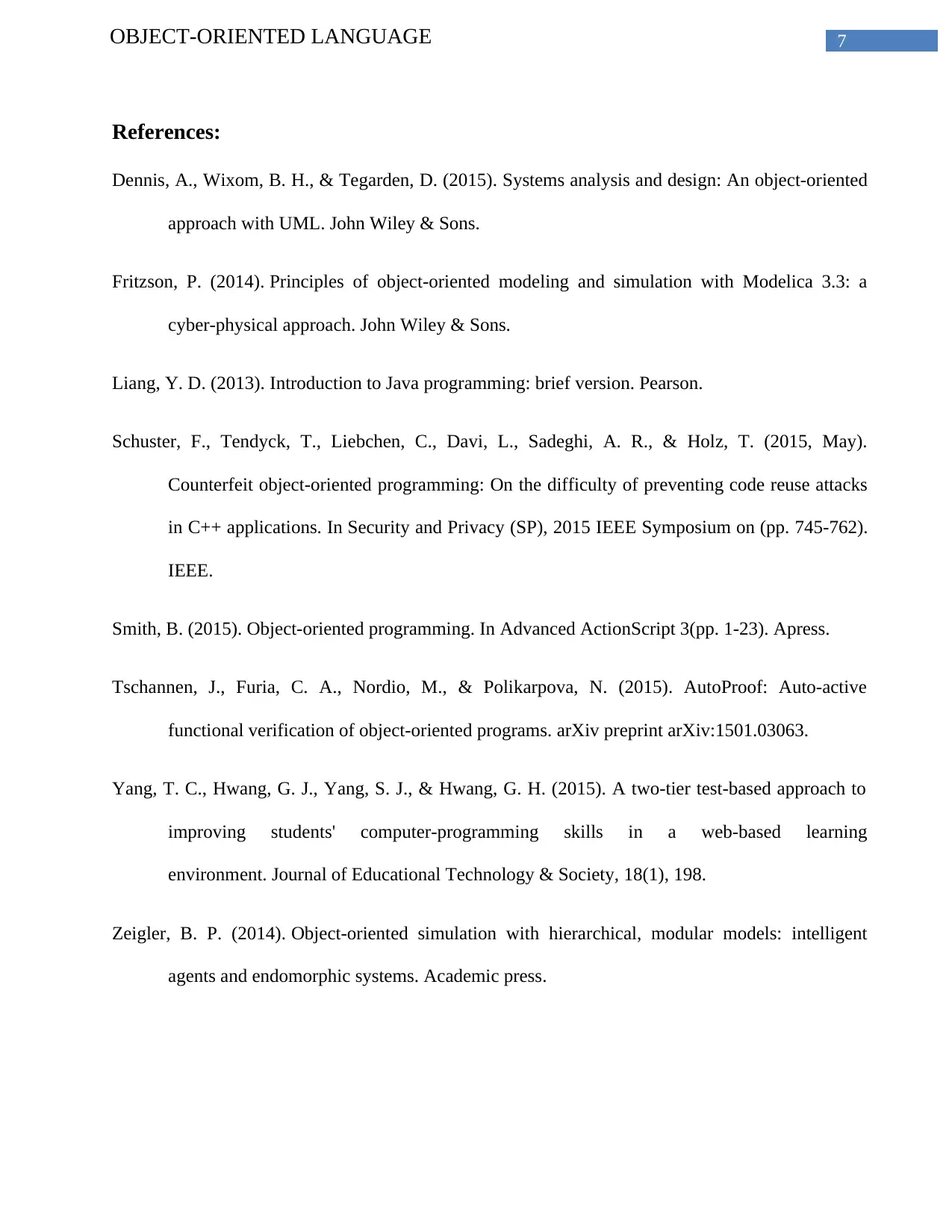
7OBJECT-ORIENTED LANGUAGE
References:
Dennis, A., Wixom, B. H., & Tegarden, D. (2015). Systems analysis and design: An object-oriented
approach with UML. John Wiley & Sons.
Fritzson, P. (2014). Principles of object-oriented modeling and simulation with Modelica 3.3: a
cyber-physical approach. John Wiley & Sons.
Liang, Y. D. (2013). Introduction to Java programming: brief version. Pearson.
Schuster, F., Tendyck, T., Liebchen, C., Davi, L., Sadeghi, A. R., & Holz, T. (2015, May).
Counterfeit object-oriented programming: On the difficulty of preventing code reuse attacks
in C++ applications. In Security and Privacy (SP), 2015 IEEE Symposium on (pp. 745-762).
IEEE.
Smith, B. (2015). Object-oriented programming. In Advanced ActionScript 3(pp. 1-23). Apress.
Tschannen, J., Furia, C. A., Nordio, M., & Polikarpova, N. (2015). AutoProof: Auto-active
functional verification of object-oriented programs. arXiv preprint arXiv:1501.03063.
Yang, T. C., Hwang, G. J., Yang, S. J., & Hwang, G. H. (2015). A two-tier test-based approach to
improving students' computer-programming skills in a web-based learning
environment. Journal of Educational Technology & Society, 18(1), 198.
Zeigler, B. P. (2014). Object-oriented simulation with hierarchical, modular models: intelligent
agents and endomorphic systems. Academic press.
References:
Dennis, A., Wixom, B. H., & Tegarden, D. (2015). Systems analysis and design: An object-oriented
approach with UML. John Wiley & Sons.
Fritzson, P. (2014). Principles of object-oriented modeling and simulation with Modelica 3.3: a
cyber-physical approach. John Wiley & Sons.
Liang, Y. D. (2013). Introduction to Java programming: brief version. Pearson.
Schuster, F., Tendyck, T., Liebchen, C., Davi, L., Sadeghi, A. R., & Holz, T. (2015, May).
Counterfeit object-oriented programming: On the difficulty of preventing code reuse attacks
in C++ applications. In Security and Privacy (SP), 2015 IEEE Symposium on (pp. 745-762).
IEEE.
Smith, B. (2015). Object-oriented programming. In Advanced ActionScript 3(pp. 1-23). Apress.
Tschannen, J., Furia, C. A., Nordio, M., & Polikarpova, N. (2015). AutoProof: Auto-active
functional verification of object-oriented programs. arXiv preprint arXiv:1501.03063.
Yang, T. C., Hwang, G. J., Yang, S. J., & Hwang, G. H. (2015). A two-tier test-based approach to
improving students' computer-programming skills in a web-based learning
environment. Journal of Educational Technology & Society, 18(1), 198.
Zeigler, B. P. (2014). Object-oriented simulation with hierarchical, modular models: intelligent
agents and endomorphic systems. Academic press.
1 out of 8
Related Documents
Your All-in-One AI-Powered Toolkit for Academic Success.
+13062052269
info@desklib.com
Available 24*7 on WhatsApp / Email
![[object Object]](/_next/static/media/star-bottom.7253800d.svg)
Unlock your academic potential
Copyright © 2020–2025 A2Z Services. All Rights Reserved. Developed and managed by ZUCOL.




